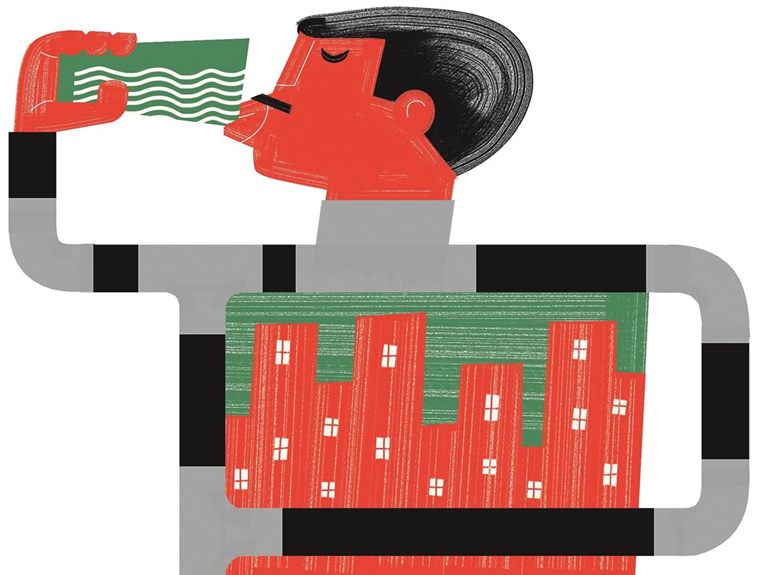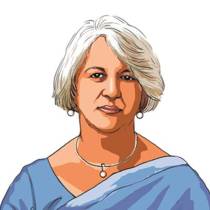Ripples of reform in Dhaka
Bangladesh capital’s transformation of the water services sector, that connects the urban poor to the piped network, has lessons for cities in India

The long journey to transform Dhaka’s water scenario began in 2005 — the same year that the Government of India launched its first national urban renewal mission, JNNURM. (Illustration: C R Sasikumar)
Dhaka, with a population of 12.5 million, is the sixth-largest megacity in the world. Indians often think we have little to learn from our neighbour Bangladesh, which has a per capita income in PPP terms less than 60 per cent of India’s. But Dhaka has a lot to teach our megacities since it has one of the worst vulnerabilities to water of any urban setting in the world, and is handling it in an inclusive manner which is also financially sustainable.
Dhaka’s water challenges are similar to what we experience in our megacities, only worse. Having polluted its rivers with industrial effluents and municipal sewage, the city remains heavily (80 per cent) dependent on groundwater for its drinking water needs. The temptation to source groundwater using deep tube wells is enormous, particularly since the water quality is good and is potable without any treatment. The water-table is at least 600 feet deep and it amounts to water mining from a resource that has accumulated over thousands of years. It has resulted in a rapid decline in Dhaka’s water table at the rate of about two to three metres per year for close to three decades. Moreover, indiscriminate suction pumps installed beneath underground tanks in the city tend to reduce or choke off pressure elsewhere in the system causing backwater and stagnation, and hence contamination of water. Only a little over 10 years ago, the WHO had declared that the entire population of Dhaka was at the risk of cholera.
The long journey to transform Dhaka’s water scenario began in 2005 — the same year that the Government of India launched its first national urban renewal mission, JNNURM. In that year, the Government of Bangladesh accorded high priority to safe water and appropriate sanitation as part of its National Poverty Reduction Strategy. The Asian Development Bank rose to the occasion by offering support to the Dhaka Water and Sewerage Authority (DWASA) to carry out reforms in the water services sector and build its capacity, while at the same time connecting the urban poor through community mobilisation.
In 2007, the piped network for distribution of water in Dhaka was in a state of disrepair with innumerable (mostly unidentified) leakages and illegal connections. It functioned as an intermittent and low-pressurised system. Loss of water due to physical leakages in the pipes was more than 50 per cent. Less than 60 per cent of the homes had water meters. Only half of the water supplied to the networks was ever billed and only 62 per cent of the water bills were actually collected. Surveys showed that many of the slum-dwellers were either using DWASA-supplied water through illegal tapping, or paying local middlemen a much higher price for the water they needed. Only one-third of the water supplied by DWASA was paid for.
This is all beginning to change. Dhaka has managed to invest enough in its water distribution infrastructure to raise the coverage of water connections in the non-slum areas to close to 100 per cent. The replacement of the old pipes has resulted in reduced physical water losses in the range of 2-14 per cent at commission. In one-third of the city, this was done by introducing district metering areas (DMAs), each one hydraulically isolated, independent of the other areas in water pressure, quantity, and quality. Since each area has entry and exit meters to measure supply within the area, it enables close monitoring of water losses and leak detection. Trenchless technology for laying pipes allowed faster execution and reduced inconvenience to the residents, so commonly observed in trench digging works in most Indian cities.
Even more than technology, what has made a difference is leadership. Taqsem Khan was brought in to head DWASA from the private sector in 2009. As managing director, he has been able to transform the utility by improving its systems, processes and the manner of interactions with the residents while not losing focus on the infrastructure improvements. DWASA has built a state-of-the art training facility to organise regular training programmes for its staff to use smart water technologies to sustain the efficiency gains.
To ensure financial sustainability, there has been tariff increase of 5 per cent every year since 2007. Non-revenue water declined from 40 per cent in 2008 to 22 per cent in 2015. In November 2016, water tariff was further raised by 17 per cent for domestic users and 13 per cent for commercial users. Further gains in bringing down non-revenue water will require maintaining/ improving efficiency levels and strengthening the revenue collection mechanisms.
DWASA has successfully completed computerisation of the entire databases of approximately 3,00,000 connections, and monthly water bills are issued from this database. Payments of water bills can be made through the internet, mobile phones and banks. A citizens’ grievance redressal centre has been established in each zone to resolve complaints regarding the services.
A significant feature of the Dhaka water transformation is that households living in slums (25 per cent of the population) are also being connected with a piped network, albeit at a much slower pace, and are paying for water without any cross-subsidy. For example, 2,100 communal metered connections were provided in 15 slum areas, each connection serving 15-25 households. Further work is going on to provide 35 slum areas with 5,000 communal metered connections. Since the slum population is projected to increase to more than 4 million by 2025, this large component of demand has been accommodated while planning for water.
A noteworthy development is that the slum residents organised themselves into community-based organisations and ensured that all water bills were paid on time. Such community mobilisation was supported by DWASA to overcome the deeply-entrenched interests of private vendors extorting unreasonable profits from the residents. The emphasis on connecting the slums demonstrated that the urban poor are a viable market to be taken seriously. The slum dwellers’ monthly usage of water puts them in lifeline consumption, a level that attracts the lowest tariffs, allowing the utility to have a pro-poor and inclusive approach. In Delhi, those not connected to the distribution network do not benefit from lifeline water since they remain at the mercy of the “official” tankers.
The results show on the ground. As Azharul Islam Khan, Chief Physician and Head of Hospitals at ICDDR, puts it “In the last couple of years we have not seen huge peaks in the pre- and post-monsoon months, as we usually did”. Mohammed Moir Hussain Khan, Health Facilitator at the Mary Stopes funded community health clinic in Shattola proclaims, “Before the water situation in this area improved, we would see 50 patients with cholera or severe dysentery each month. Now only five to seven patients come for that”.
As with megacities in India, highly inadequate drainage and sewerage networks, and lack of sewage treatment continue to pose major challenges — 70 per cent of the city has no form of sewerage and there is little sewage treatment. As DWASA’s efforts have gathered momentum, a number of other donors have stepped forth to be a part of the movement. The World Bank is currently engaged in supporting work on sewerage and sewage treatment for Dhaka. Finally, the shift from groundwater to surface water will have to be planned and implemented. It will be a long haul, but as Lao Tzu, the Chinese philosopher, put it, “a journey of a thousand miles begins with a single step”.
The writer is chairperson, ICRIER, Delhi, and former chairperson of the high-powered expert committee on urban infrastructure and services.
For all the latest Opinion News, download Indian Express App
More From Isher Judge Ahluwalia
- Cities at Crossroads: Who pays to save this lake?Bengaluru waterbody, Jakkur, restored by a citizen’s initiative, now stands to be deprived of water by a power plant, raising questions about making environmentally sound…
- Cities at Crossroads: Bring back the lakesCitizen action on rejuvenation of water bodies is gathering momentum in Bengaluru and is making a difference on the ground...
- What urban waste has to do with global warmingRecycling, composting and biomethanation will not only make landfills unnecessary, they will also help reduce greenhouse gas emissions. ..








































No hay comentarios:
Publicar un comentario